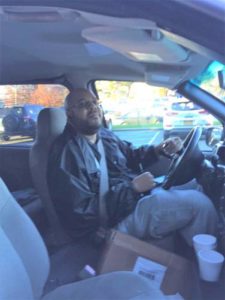By Charlie Italiano, Esq., Health Advocate
CHARLIE BEHIND THE WHEEL: “I was surprised to see that I still had the ability to do it”

For the past 16 years I have been a quadriplegic. I have had to rely on other people for transportation. I used Bee Line ParaTransit to commute to law school, and I continue to use it to commute to work here at Westchester Disabled on the Move, Inc. (WDOMI). I had pretty much written off the possibility of driving for a couple of reasons:
 1. My spinal cord injury causes a lack of innervation in my lower and upper extremities, meaning that I have no function in my legs, and the only muscles in my upper extremities receiving signals from my brain are my wrist extenders and biceps. I do not have use of my hands, fingers, or triceps, so my strength, dexterity, and range of motion are very limited.
1. My spinal cord injury causes a lack of innervation in my lower and upper extremities, meaning that I have no function in my legs, and the only muscles in my upper extremities receiving signals from my brain are my wrist extenders and biceps. I do not have use of my hands, fingers, or triceps, so my strength, dexterity, and range of motion are very limited.
2. The equipment that enables someone with my condition to operate a vehicle is cost prohibitive. On top of the cost of a van, the modifications necessary to allow me to enter and operate the vehicle cost $105,000.
Because of these factors, I thought I was relegated to a lifetime of being a passenger and having to prearrange transportation for every place I needed to go. However, that all changed when I started working at WDOMI. A former colleague with a very similar disability had a van modified for him to drive, and to my surprise, had the modifications paid for by New York State. ACCESS VR, which is a part of the NYS Education Department, will assist with payment for equipment and services that help people with disabilities become and remain employed. I started the process of attaining van modification by meeting with my ACCESS VR counselor last July, and the process is moving along nicely.
My counselor authorized a driving rehabilitation specialist to come to my home to assess my physical abilities and determine what type of controls would work best for me. The following week, the driving instructor drove a modified van to my home. He secured my wheelchair where the driver’s seat would normally be, showed me how the controls work, and told me to pull out of the driveway. I used to drive before I became disabled, and I was surprised to see that I still had the ability to do it. My spatial awareness was still good; I was able to stay in lanes, back into parking spaces, and generally just drive. It was a lot of fun to be back on the road.
At this point in the process, I only need to become comfortable with the hand controls in order to move on to the next step, which is requesting approval from ACCESS VR for van modification services. The van in which I am training uses the Scott driving system. I put my hand into a joystick that secures my arm in place, and actually controlling the car is quite simple. To accelerate and brake, I only need to push my arm forward and pull backward, respectively. Turning is accomplished via pronation and supination of the forearm. All of these controls are mechanically and hydraulically assisted, so my lack of strength does not hinder my ability to use these controls. All of the other functions for driving and operating the car, e.g. headlights, wipers, signals, etc., are routed to a box that is placed in an ideal location for access. Overall, I am very encouraged, and looking forward to having a much greater degree of independence.
(STAY TUNED FOR MORE PICTURES OF CHARLIE BEHIND THE WHEEL AFTER HE STARTS DRIVING TO WORK ON HIS OWN)